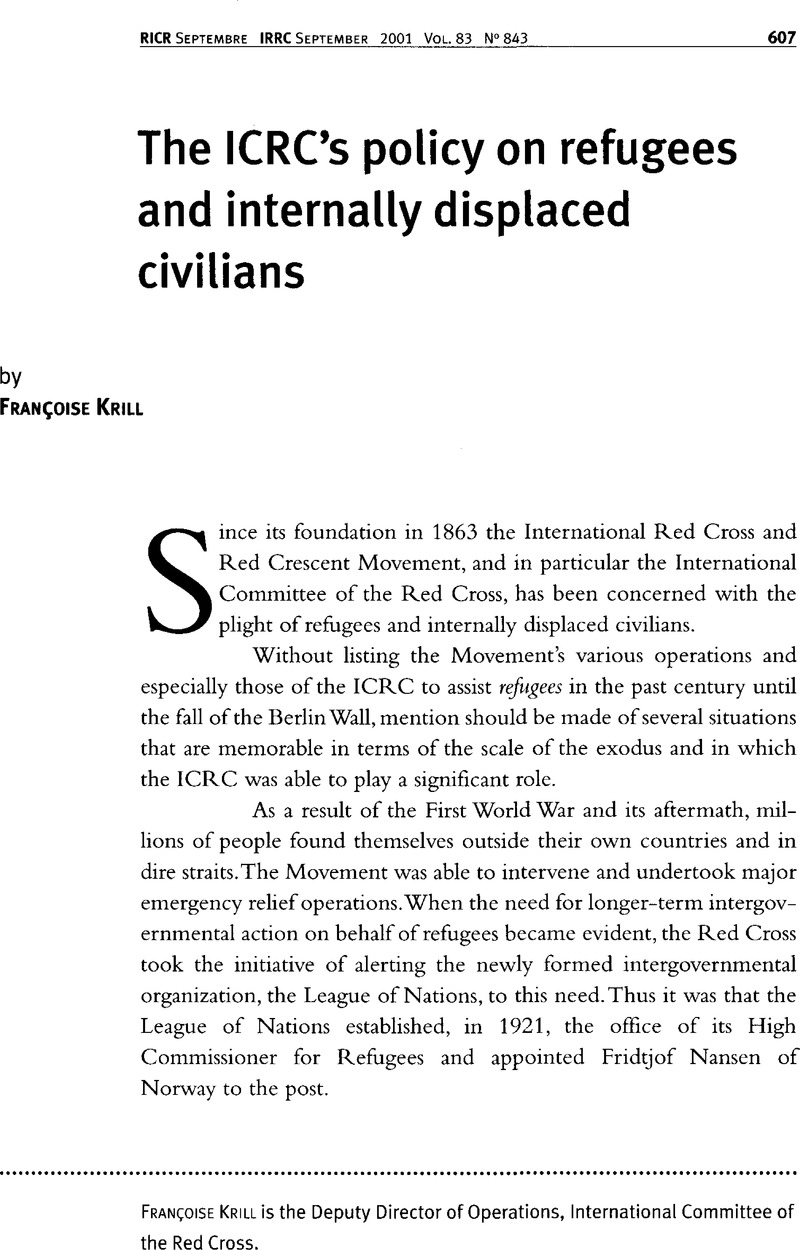Published online by Cambridge University Press: 19 April 2010

1 Now the International Federation of Red Cross and Red Crescent Societies.
2 Schnyder, F., The Red Cross and the Refugees, UNHCR, Geneva, 1963, pp. 5,6 and 11.Google Scholar
3 Under Article 8 of the Movement's Statutes, “[t]he International Conference is the supreme deliberative body for the Movement. At the International Conference, representatives of the components of the Movement meet with representatives of the States Parties to the Geneva Conventions, the latter in exercise of their responsibilities under those Conventions and in support of the overall work of the Movement.…”.
4 Op. cit. (note 2), pp. 16 and 17.
5 Bugnion, François, Le Comité international de la Croix-Rouge et la protection des victi- mes de la guerre, ICRC, Geneva, 1994, pp. 947–948.Google Scholar (Shortly to be published in English entitled The International Committee of the Red Cross and the Protection of War Victims.)
6 Ibid., p. 904.
7 Op. cit. (note 2), p. 12.
8 In 2000 the ICRC forwarded nearly one million family messages, traced 2,457 missing persons, received 6,092 new tracing requests and reunited 2,481 persons with their families.
9 Op. cit. (note 5), p. 657.
10 ICRC Annual Report 1993, p. 76.
11 ICRC Annual Report 1994, p. 53.
12 The legal protection afforded by international humanitarian law is the subject of other articles in this issue of the Review.
13 Resolutions IX, IV and XXXI, adopted respectively by the 10th, 12th and 17th International Conferences of the Red Cross in 1921 and 1925 (Geneva) and in 1948 in Stockholm.
14 Resolution XVII of the 25th International Conference (Geneva, 1986) and Resolution 4 of the 26th International Conference of the Red Cross and Red Crescent (Geneva, 1995). See also Resolutions 9 and 7 of the Council of Delegates (Budapest, 1991 and Birmingham, 1993).
15 Plan of Action for the years 2000-2003, IRRC, No. 836, December 1999, pp. 880-895, esp. p. 890.
16 16 Art. 12 of the Movement's Statutes: “The Council of Delegates… is the body where the representatives of all the components of the Movement meet to discuss matters which concern the Movement as a whole”.
17 Agreement on the Organization of the International Activities of the Components of the International Red Cross and Red Crescent Movement, of 26 November 1997, IRRC, No. 322, March 1998, pp. 159-176.
18 Ibid, Art. 5.1, letter A) d).
19 Ibid., Art. 5.8.
20 Art. 1 A (2), Convention relating to the Status of Refugees, of 28 July 1951. The Protocol relating to the Status of Refugees, of 31 January 1967, abolishes the time and geo graphical limitations.
21 Art. 1, OAU Convention Governing the Specific Aspects of Refugee Problems in Africa, of 10 September 1969.
22 Arts 44 and 70, para. 2, of the Fourth Geneva Convention of 1949 and Art. 73 of Additional Protocol I.
23 ICRC Annual Reports from 1983 to 1988, pp. 59, 62, 68, 67, 77-78 and 79, respectively.
24 See Art. 5, para. 3, of the Movement's Statutes: “The International Committee may take any humanitarian initiative which comes within its role as a specifically neutral and independent institution and intermediary, and may consider any question requiring examination by such an institution.”
25 Kosirnik, René, “Droit international humanitaire et protection des camps de réfugiés”, in Studies and Essays on International Humanitarian Law and Red Cross Principles, in Honour of lean Pictet, ICRC/Martinus Nijhoff Publishers, Geneva, 1984, pp. 387–393Google Scholar.
26 The ICRC, together with UNHCR, UNICEF and several international NGOs, is currently preparing a document summarizing common principles of action for unaccompanied children entitled “Guiding principles or unaccompanied and separated children”.
27 With regard to Cambodia, the ICRC's memorandum of 14 November 1990 is partially reproduced in: Frederic Maurice/Jean de Courten, “ICRC's activities for refugees and displaced civilians”, IRRC, No. 280, January/February 1991, pp. 9–22Google Scholar.
28 Lavoyer, Jean-Philippe, “Refugees and internally displaced persons: International humanitarian law and the role of the ICRC”, IRRC, No. 305, March-April 1995, pp. 162–180CrossRefGoogle Scholar.
29 The Hague Convention (V) respecting the Rights and Duties of Neutral Powers and Persons in Case of War on Land, 18 October 1907, applies formally in the context of international conflicts; it may also be applied by analogy to internal conflicts.
30 The Civilian Character of Asylum — Separating Armed Elements from Refugees, ICRC's statement to the UNHCR Global Consultations on International Protection, first meeting, 8-9 March 2001.
31 UN Doc. E/CN.4/1998/53/Add.2.–This document defines displaced persons as follows: “internally displaced persons are persons or groups of persons who have been forced or obliged to flee or to leave their homes or places of habitual residence, in particular as a result of or in order to avoid the effects of armed conflict, situations of generalized violence, violations of human rights or natural or human-made disasters, and who have not crossed an internationally recognized State border”. See also Lavoyer, Jean-Philippe, “Guiding Principles on Internal Displacement”, IRRC, No. 324, September 1998, pp. 467–480CrossRefGoogle Scholar.
32 “It should be noted that the ICRC has a specific mandate to provide protection and assistance to victims, including IDPs, of armed conflicts, internal disturbances and tensions. In general, ICRC's mandate is discharged in close cooperation with National Societies of the Red Cross/Red Crescent supported by their International Federation. The National Societies are mandated to assist the most vulnerable within their own countries, including IDPs, and are often the first and only organization present at the inception of a disaster.” Reproduced in Supplementary Guidance to Humanitarian/Resident Coordinators on their Responsibilities in relation to IDPs, 5 April 2000.
33 Sassoli, Marco, “La première décision de la chambre d'appel du tribunal pénal international pour I'ex-Yugoslavie: TADIC (compétence)”, Revue générate de droit international public, Vol. 100, No. 1, 1996, pp. 101–134.Google Scholar